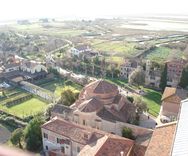
|

TORCELLO ISLAND
The island of Torcello is located in Venice's
Lagoon, beyond Mazzorbo and Burano. Torcello island is sparsely populated
with a population less than 30, with some of them living in
farm-houses. On Torcello island is active fishing and
farming even if the main resource is
tourism. The origins of Torcello island are more ancient
than those of Venice. Escaping from the barbarian
hordes, many inhabitants from Altino found refuge in this
far corner of the lagoon. They came from the Altino's
area called Turris as there was a tower located nearby,
for this reason they called Turricellum their new
country. Since 638 the bishop Paolo from
Altino moved his seat to Torcello island, bringing the relics and
the bodies of the saints. The importance of Torcello island grew and it
became a famous trade center which included wool
production. On Torcello island were built many churches and convents; its
population grown to 20,000 inhabitants.
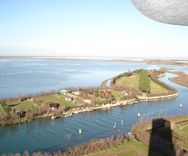
Torcello was sorrounded by
many other islands, the most celebrated were
Ammiana and Costanziaca, which
have actually disappeared. The importance of the island reduced when
the doge's seat moved to "Metamaucus" first, and to
"Rivoaltus"
later (813); but it remained an important location until the fourteenth
century. At that time, as both Piave and Sile rivers left their
natural river-beds to flow into the lagoon, resulting in a
progressive sanding all around Torcello island. As a result there was a
drastic reduction of trade and finally malaria hit the island. This
disease forced the population to abandon Torcello island and to move to
Venice, leaving the island run wild. Torcello island's churches and palaces
were plundered. The building materials were re-used to build
elsewhere. Torcello island's area was reclaimed during the nineteenth century,
but unfortunately very little of its ancient splendor
remained.
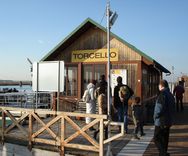
Torcello island is easily reachable from Burano.
Actv offers during the
day a regular link to the island by public waterbus service (vaporetto, line 9). From the Burano
stop there are departures every
30 minutes and, crossing the "Canale dei Borgognoni" the vaporetto
gets to Torcello island in approximately 5 minutes. Beyond the Actv stop
you have to walk along a waterfront arriving to some shops and
restaurants. Along the waterfront you can see the "Ponte del
Diavolo" (Devil's Bridge), a rare example of a
bridge without lateral supports (called "spallette"), that linked
the inhabitated part of Torcello island with the cultivated
one. Following and then crossing a bridge you get in
the Torcello's church complex. From the stop it's an
approximately 8-minute walk and you must remember this time if
you don't want to miss the vaporetto and wait 30 minute for the next
one.
Restaurants in Torcello island
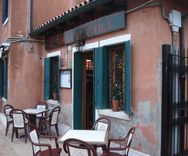
Ristorante al Trono di Attila, Torcello, tel. +39 041 730094.
Locanda Cipriani, Torcello, tel. +39 041 730150.
Ostaria Ponte del Diavolo, Torcello, tel. +39 041 730401.
Ristorante Villa '600, Torcello, tel. +39 041 5272254.
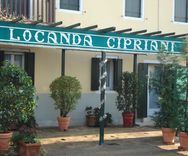
On the right is the celebrated Locanda
Cipriani that hosted many famous people, among them Queen
Elizabeth II, Price Charles and Lady Diana, the soprano Maria
Callas, Italy's President Sandro Pertini, the actor Charlie Chaplin,
the novelist
Ernest Hemingway (the list would be much longer).
Hemingway stayed many
times at the locanda since 1948. Here in Torcello island he loved to relax and from
here he started his hunting-parties. In this property the American author wrote
the novel "Across the River and Into the Trees".

Beyond
the locanda are available some kiosks selling souvenirs and lace made in
Burano. Then
you get to the unpaved main square in Torcello island, covered
with grass. From this place it is possible to see the last important
buildings remaining today. First you see "Attila's
Throne", a seat
made in white marble probably used by Torcello's bishop or by the
local tribune long time ago. There is no witness about the seat has
been really used by the Huns' army leader, that plundered the Po
Valley in 452. In the square is remarkable a nice well-curb as
well.
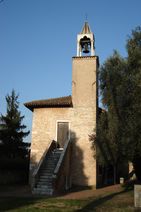
In front and on the left
side of the square is remarkable the Council Palace in
gothic style (built during the fourteenth century and at that age
seat of the local government), and the Archives'
Palace. Both buildings constitute the Torcello island's Museum, an
archaeologic collection of Latin, Byzantine and medieval ages, all
its finds were discovered on the island. The Council Palace was
bought in 1870 by the count Torelli that, after a 2-year
restoration, gave it as a gift to the Province. In 1877 it
was C.A. Levi that bought and restored the Archives' Palace.
Finally it was possible to see in 1887 the "Museo
dell'Estuario" (Estuary's Museum), named later "Museo
di Torcello" and property of Venice's Province. On the stairs located
in the Archives' Palace you can have a beautiful sight of the
lagoon.
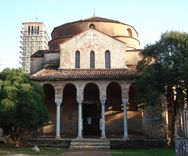
On the right side of Torcello square is the
Santa Fosca Church, built
between the eleventh and the twelfth century. Outside is remarkable a
porch on five sides and inside it is possible to see the strict
pentagonal apse. This small building is admirable for its proportioned
dimensions and for the armony of the architectonic elements. Beyond
this small but nice church is remarkable the rest of the
Baptistery (circle shape, medieval age). During the high tide
the sea water gets inside, reminding us that we are still in the
lagoon.
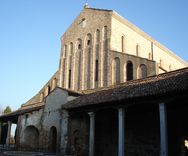
Finally you get to Santa Maria Assunta
Cathedral, (+39 041 730119, open daily 10,30am-6pm, ticket office is open till 5,30pm)
built in 639 by the Ravenna's exarch, Isaacio.
The admission is 3 euros. The building had
restorations in 864 and 1008 but the present construction looks
typical of the Veneto-Byzantine age. The church
inside is solemn with a floor made by rich marble mosaics. Above the
"Porta Maggiore" (Main Gate), is located the wonderful mosaic
titled "Christ's Aphoteosis" and "Last Judgement",
a real masterpiece attributed to Veneto-Byzantine school (twelfth
century). On the apse is the mosaic "The Virgin and the Apostles".
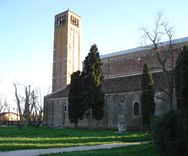
This cathedral represents the most ancient monumental building in
Venice's Lagoon. Are remarkable some curious and huge shutters located
outside that repair the windows on the side of the building. Paying an
additional charge to the church's admittance it is possible to visit
the bell tower (eleventh
century), climbing a ramped stairway you get a really nice view of
Torcello island.
The remarkable art of the mosaic was brought into Veneto
region by the Romans during the early Christian age. But its
best examples are still the mosaic floors of Aquileia, in
Friuli region (4th cen.). The mosaic was brought much
later in Torcello island and into some abbeys located in the lagoon,
from the 6th cen.. The artists of mosaic that worked in
Torcello island have been probably the same that created the fantastic
mosaics of St. Mark's Basilica.

In the nearby of Torcello island you can visit, but only with private meanings
of transportation, some islands that in ancient times were remarkable but
actually are completely abandoned. Among the most important are: S. Arian,
Le Saline and La Cura. The first (called S. Adriano as well) had
an important convent of nuns but it was abandoned for its unhealthy
air. In 1565 a law of Venice Senate converted it in a charnel house.
Actually the doors are walled to avoid the theft of bones. Le Saline
was used in order to get salt until 1913, the last family that lived
there left the island at the end of the 60's. La Cura was probably linked
with S. Arian, in the nearby of Torcello, both islands formed a whole with
the wonderful Costanziaca. The name "Costanziaca" maybe is in
honour of the emperor Costante that ruled in Bisanzio after 641 a.d., or
the name could come from a gate of the ancient city of Altino.
Budget hotel in Venice
|